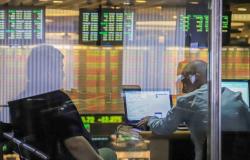The market has its sights set on Europe. After the strong revaluations that the stock markets have accumulated since November, and the improvement in the economic outlook shown by the most recent data, investors need more details to unleash the gains. And one of the elements is the path of interest rates, as was evident on Thursday when, after Christine Lagarde’s rate cut and subsequent press conference, European indices recorded gains of close to half a percentage point. Although there are still many unanswered questions, in recent weeks the idea that European equities still have a way to go has begun to gain strength.
Moody’s analysts reiterate that cutting interest rates will help boost growth. This, combined with inflation that is cooling faster than in the United States and prospects that suggest that profits will end the streak of four consecutive quarters of decline and grow by 3% in the second quarter, create the conditions for the Stoxx 600 once again sets new records. “It’s a good combination for the stock market,” says Lilia Peytavin, portfolio strategist at Goldman Sachs. The ECB complied with the planned script and carried out the first rate cut in eight years, but the upward revision of inflation indicates that, as some of the officials and Christine Lagarde herself have been pointing out in recent weeks, the policy Monetary will continue to be restrictive. Furthermore, the fear of undoing the progress of the last two years and the reluctance shown by the Federal Reserve to lower the price of money limit the margin of action of the European institution. The good news is that, today, the delay in new rate cuts does not seem capable, by itself, of derailing the market trend.
Economic theory states that monetary relaxation is an incentive for the stock markets. In addition to boosting growth and reducing the rate at which future profits are recorded – something that has a special impact on sectors such as technology – it lowers the cost of financing. By having to pay less for debt, companies’ ability to increase margins grows. According to Goldman Sachs calculations, since the 1980s European stocks have risen 2% in the month following a Fed rate cut, double the return in any month. These promotions are extended to 6% in six months and 10% in the following 12 months. Increases a year later tend to be much stronger when accompanied by a robust economy.
Unlike what happened in the last two decades, this time the reduction in rates is not due to a slowdown in the economy, but rather responds to the moderation of prices. “The alignment of all these stars makes us think that it could be a good time to overweight the European stock market,” says Thomas Zlowodzki, strategist at Oddo BHF. Beyond the expectations generated by monetary flexibility, Ignacio Cantos, director of Atl Capital, remembers that what is essential for the stock markets to continue the upward trend is for companies to increase profits.
perfect period
UBS, which in its latest reports has reiterated the possibility of the European stock market taking the lead, reaffirms its preference for stocks from the Old Continent. The Swiss entity believes that the region is entering a perfect period now that the ECB is beginning to lower rates, the economy is improving and European listed companies are undervalued when compared to the multiples of the American ones. The entity gives a potential for European equities of between 2% and 3% in the short term.
However, as the analysis firms had been pointing out, the president of the ECB tempered spirits and refused to commit in advance to any specific rate path. Chris Iggo, chief investment officer at AXA IM, highlights that to achieve the 2% target, real rates will likely have to be in the range of 3-4% in the US and 2-3% in the eurozone. Although inflation has moderated, the expert warns that it continues to be well above the average for the 2010-2020 period. “Following the 2008-2009 crisis, disinflation was driven by globalization, shrinking balance sheets and the impact of technology on the costs of goods and services. To return to those days we will need a benign combination of lower commodity prices, greater penetration of low-cost imports and probably higher unemployment,” he highlights. That is to say, the complete opposite of the current scenario in which geopolitical risks and protectionist trade policies set the course and stop the decline in prices.
In line with the market consensus, which foresees a maximum of two more reductions in the remainder of the year, Iggo expects that monetary easing will be limited. In a scenario of higher rates, the expert considers an avalanche of money from cash to fixed income and stock markets unlikely. Investors with cash assets or short-term fixed income strategies benefit from interest income without taking on much risk and keeping volatility under control. “Going out of cash will not be easy. A year ago there was an expectation that there could be a surge of flows from the money market into fixed and equity income as central banks encouraged the idea of significant cuts,” he recalls. Having ruled out this scenario, AXA IM defends that as long as central banks do not cause a recession to meet their inflation objectives, the stock market and high-yield debt remain attractive options. “The market has rewarded those who take risks and the macroeconomic context seems to continue to be that way,” he highlights.
Natalia Aguirre, director of analysis at Renta 4, is optimistic and points out that as long as the economy and results continue to hold up, the reduction in rates can be one more catalyst that serves as a boost to the stock markets. The analysis firm continues to see the Ibex at 12,650 points at the end of the year. That is, they give it a potential of 10.53%. What many analysts doubt is the fact that European equities will finally be able to beat the US one. Although fundamentally Europe is beginning to be better positioned, Juan José Fernández Figares, investment director at Link Gestión, recalls that, given the leadership and weight of US technology in the stock market, it seems difficult for European equities to overtake US ones. . “More in the medium term, stocks from the Old Continent will reduce the strong discount at which they are trading in relation to American stocks,” he emphasizes.
Fattening results
As was already seen on Thursday, a day in which listed Spanish banks recorded gains of between 3% and 1% on the stock market, the contained reduction in rates does not threaten the reign of the financial sector. Since the ECB put an end to the era of zero rates, European banking has scored 62.9%, well above the 50.22% recorded by technology, a sector in full bloom due to the furor generated by artificial intelligence . With rates that will continue to be high, analysis firms expect that banks will continue to increase their results. Added to this are the drums of banking consolidation that have returned to the forefront with BBVA’s takeover of Sabadell and the statements of the French president, Emmanuel Macron, encouraging mergers between the main European banks to strengthen the financial integration of the EU.
Although banks continue to enjoy a good tone supported by rates and expectations of an increase in credit demand in the heat of the European recovery, Antonio Castelo, an analyst at iBroker, points out that monetary relief should benefit highly indebted sectors and who are forced to make significant investments to develop their activity. Within this group are renewable companies such as Solaria and Acciona Energía, as well as infrastructure managers (Cellnex or Red Eléctrica) and SOCIMIs. In addition to the new rate scenario, these businesses are greatly favored by the rise of data centers that consume a lot of energy and require real estate for their locations. Along with this, the expert highlights those businesses in which interest rates are determining factors in their valuation. That is, technology companies for which a significant part of the valuations are calculated with revenue forecasts, which lose value in a scenario of rising rates. The circle of sectors benefiting from monetary flexibility is closed by those related to leisure and tourism. The fall in inflation contributes to the increase in disposable income and gives consumers room to feel more confident about spending.
However, all that glitters is not gold and experts remind that there are still many factors that can derail the markets. Although, as Cantos points out, in recent months geopolitical risks have been a buying opportunity, from iBroker they remember that geostrategy can move the markets on its own regardless of the macroeconomy and the fundamentals of the companies. In addition to the two wars that ravage the planet and that have demonstrated their great influence on the prices of raw materials, experts point to the increase in trade tensions between the United States and China as the US elections approach. The doubts generated by US policy and the fear that the situation will go wrong has accelerated activity in the debt market and in the first quarter issues in euros reached a record, even surpassing the activity recorded in the era of zero rates. Along with geopolitics, Aguirre points out as the main threats that inflation refuses to continue falling and thus does not allow rate cuts, that the cycle deflates too much in the US or does not recover in Europe and that this ends up affecting the results. business.
Follow all the information Five days in Facebook, x and Linkedinor in our newsletter Five Day Agenda
Newsletters
Sign up to receive exclusive economic information and the financial news most relevant to you
Sign up!






